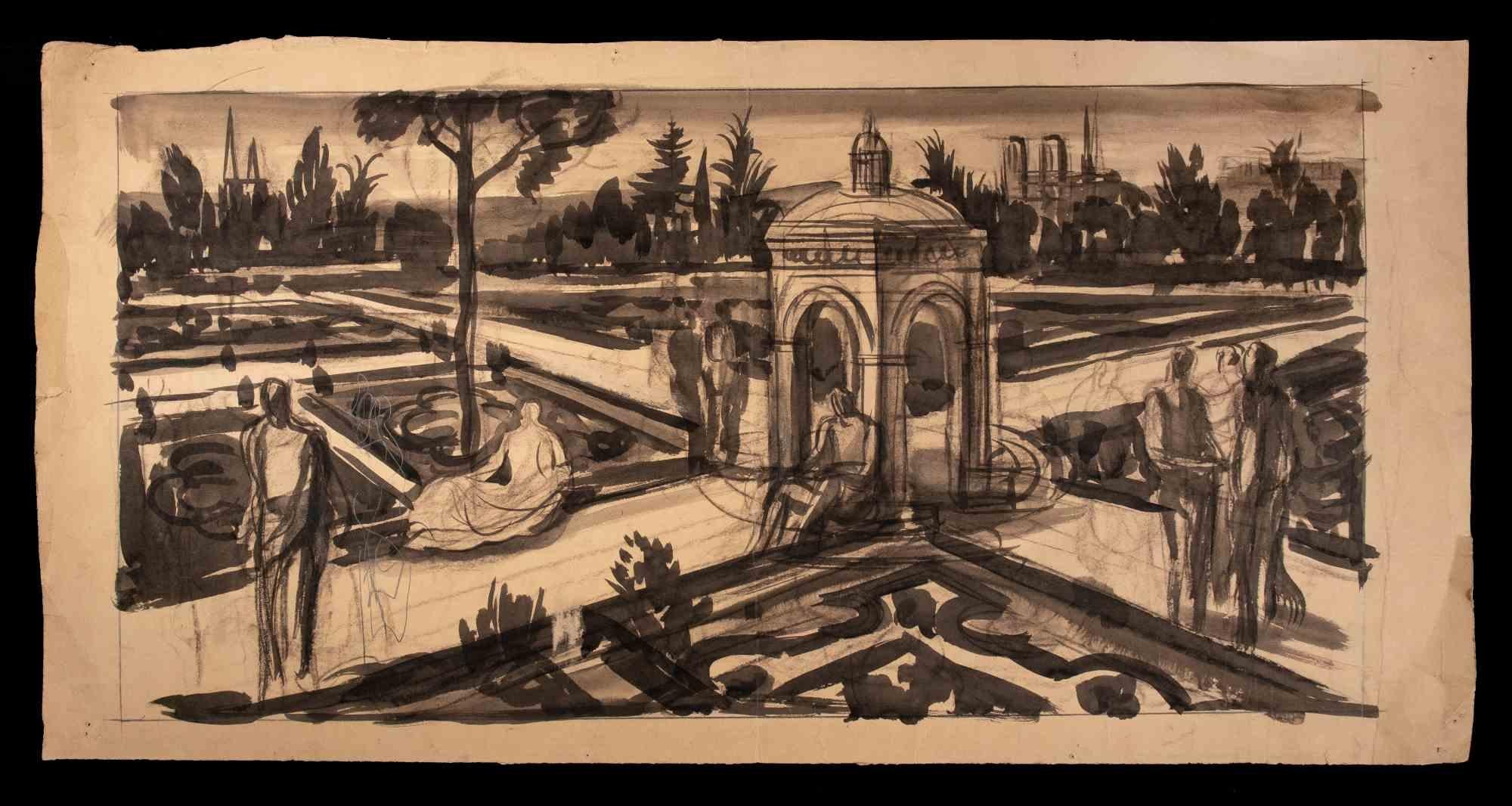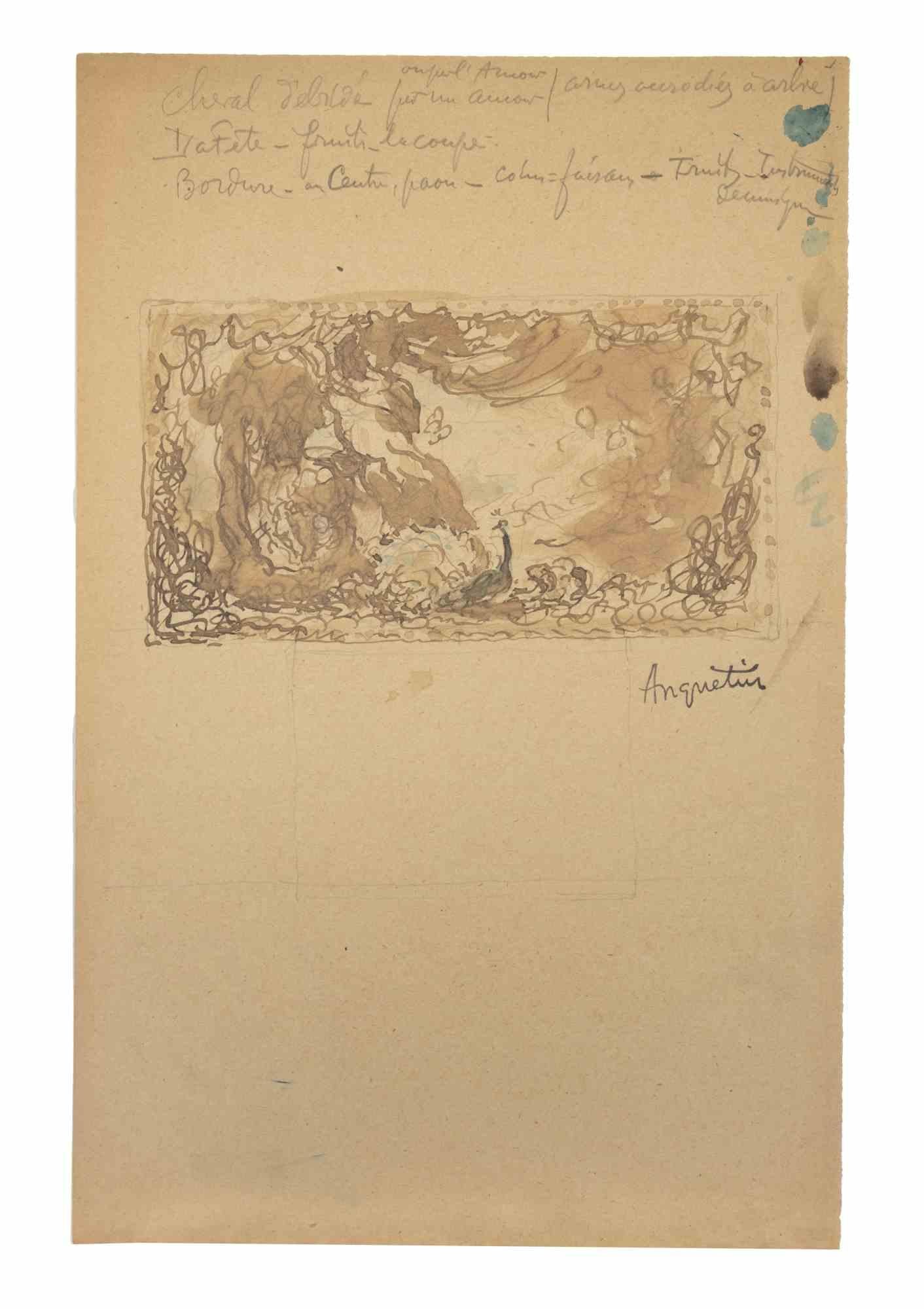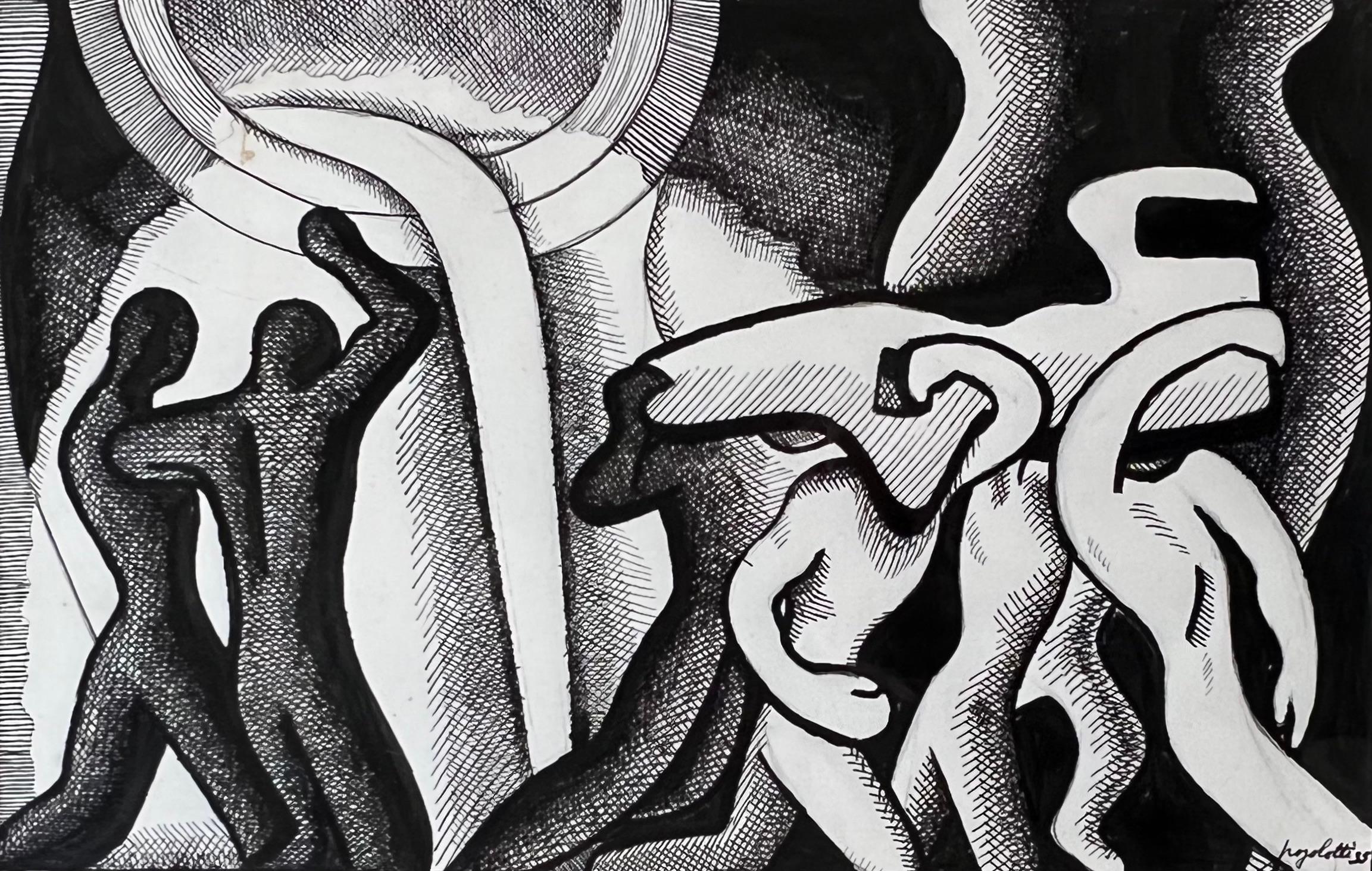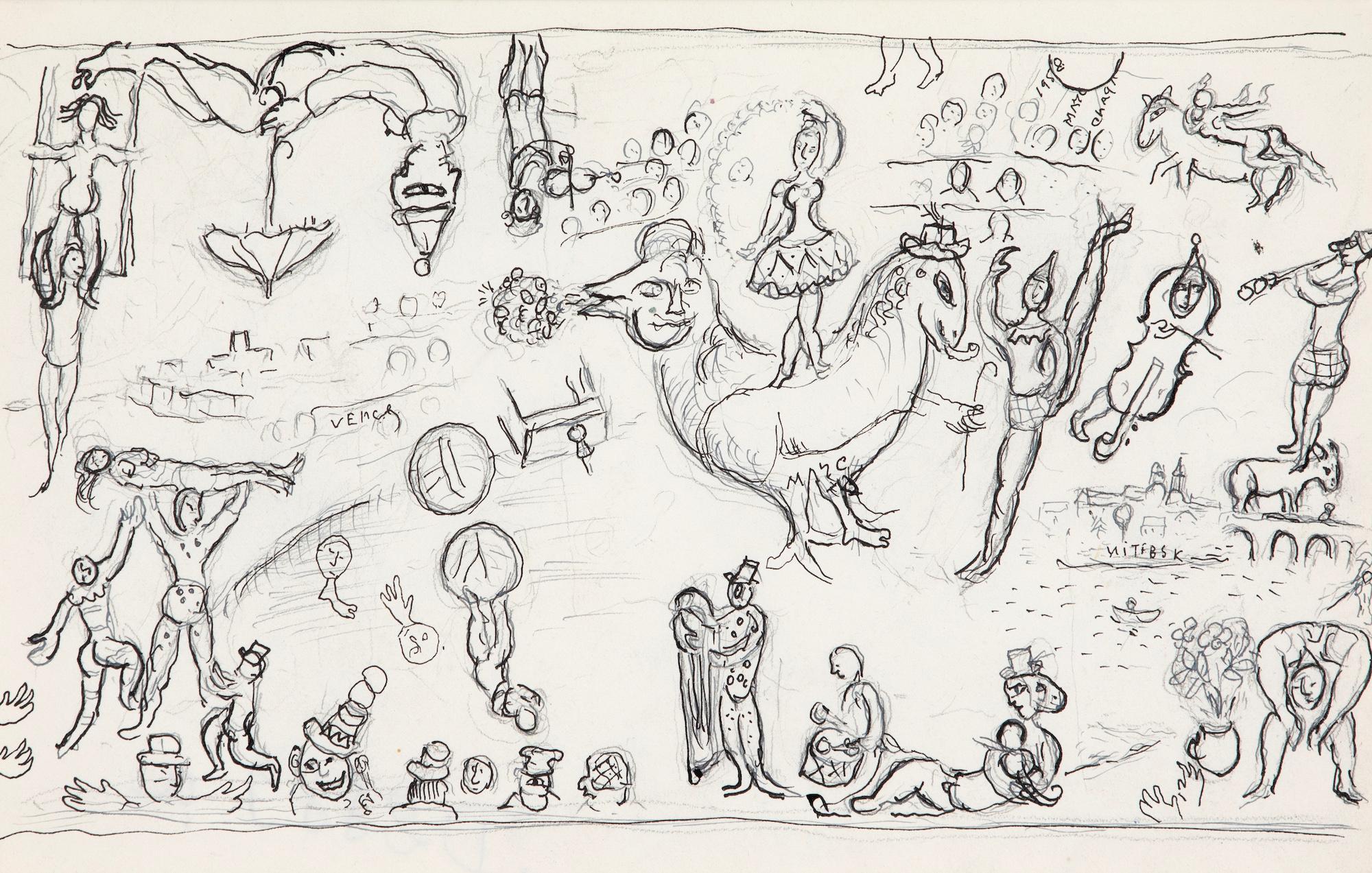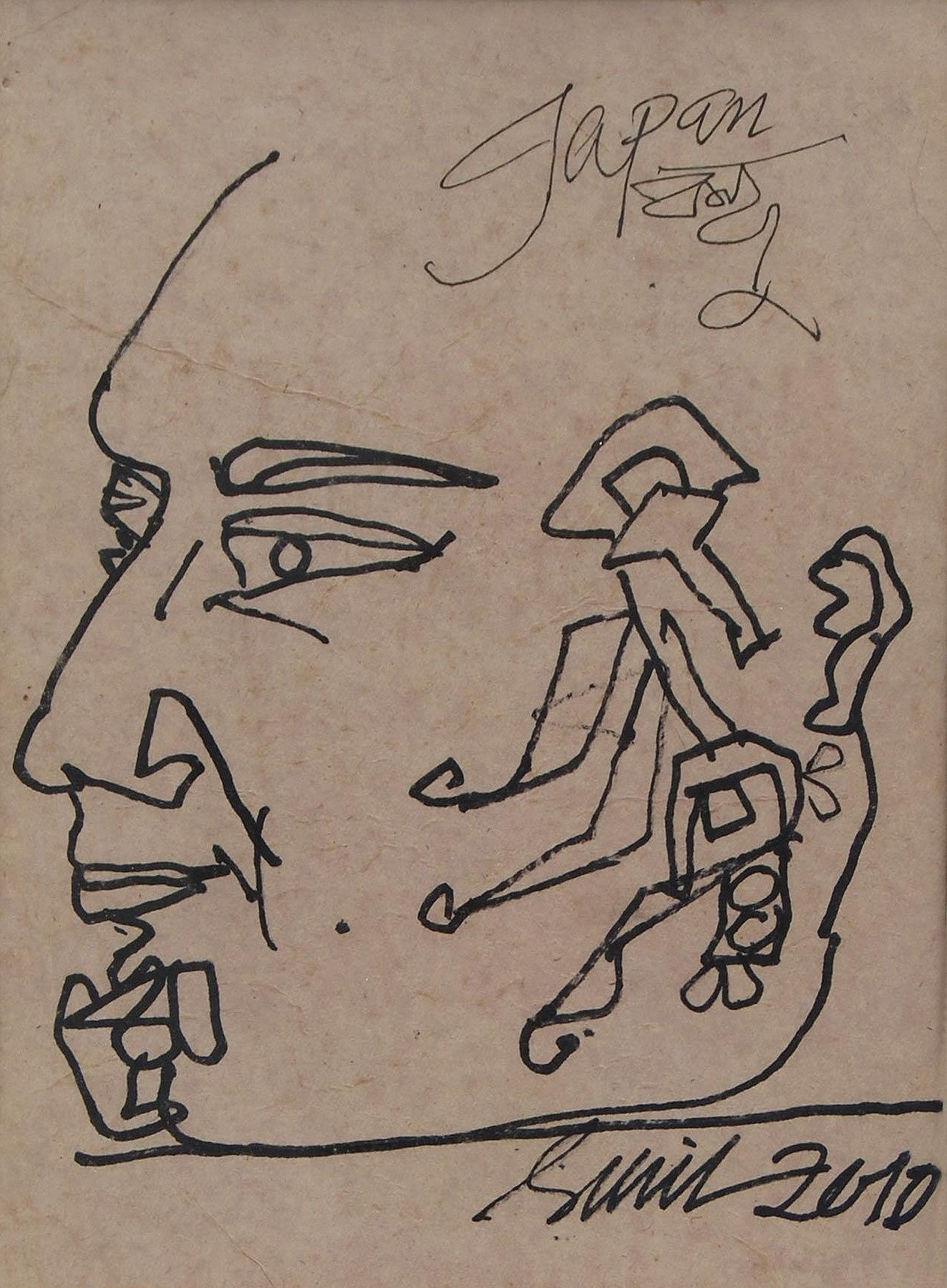Items Similar to Mid Century Modern British 'Listeners' by British German illustrator Kapp, 1959
Want more images or videos?
Request additional images or videos from the seller
1 of 8
Edmond Xavier KappMid Century Modern British 'Listeners' by British German illustrator Kapp, 19591959
1959
About the Item
Edmond Xavier Kapp (British, 1890 – 1978)
Listeners
Inkpen
Signed, inscribed and date ‘Listeners / Kapp 59’ (lower left)
7.5/8 x 10.1/2 in. (19.4 x 26.7 cm.)
Edmond Kapp was born in Islington, London, on 5 November 1890, of American and German Jewish parentage. He gave himself the middle initial ‘X’ – sometimes said to stand for Xavier – to distinguish himself from his father Emil Kapp, who was a wine merchant. However, his parents called him ‘Eddie’ while his wife and friends knew him as ‘Peter’.
During his early years, Kapp was continually ill and, while convalescing, entertained himself by drawing at home. As his health improved, he attended Dame Alice Owen’s School, Islington (1903-10), with periods at Berlin University (1909) and L’Institut Français pour les Etrangers, Paris (1909). He then read Languages at Christ’s College, Cambridge (1910-13), though spent most of his time writing and drawing.
Kapp took a studio in London, and worked intensively until the outbreak of the First World War, contributing to the Daily News, the Onlooker and other periodicals. During the war, he served as a 2nd Lieutenant in the Royal Sussex Regiment on the Western Front, and then in Intelligence, rising to the position of Staff Captain on Haig’s Staff. Finally, he founded and directed the Neutral Press Counter-propaganda Section.
In 1919, Kapp returned to London and, after abortive periods at three art schools, worked alone. In that year, he made his name with an exhibition of caricatures, held at Furst’s Gallery, London, and accompanied by a catalogue introduced by Max Beerbohm. This soon led to contracts with three London periodicals and a book of caricatures, Personalities, published by Martin Secker. Through the 1920s and 30s, his drawings of musicians and other personalities appeared in a wide variety of periodicals, most notably Time & Tide; were collected in further volumes; and were exhibited at the Leicester Galleries. He considered himself to be a ‘character-portraitist’, producing images of psychological not satirical power, and disliking the term ‘caricature’.
Between the wars, Kapp developed other aspects of his artistic talents, the desire to study and the search for subject matter often taking him abroad. For instance, work at the British Academy, Rome, under Antonio Sciortino, and with the American painter, Maurice Sterne, led him to produce his first oils (1923); while an introduction to the League of Nations in Geneva allowed him to use his new-found skill in lithography to produce portraits of twenty-five of its members (1933-35). This expansive and exploratory attitude to his work resulted in an increase in patrons and exhibitions, and in important artistic friendships, notably with Picasso (Picasso sat for Kapp in 1938).
Kapp worked as an Official War Artist during the Second World War, and then as an Official Artist to UNESCO. In the post-war period, he had a studio in Beausoleil, Alpes Maritimes, and explored abstract painting ‘passionately, though without dogmatism’ (Edmond Kapp, London: Whitechapel Art Gallery, 1961, page 8).
Kapp died on 29 October 1978. His sister – the artist Helen Kapp – had died earlier in the same month. The first of his three wives was Yvonne Kapp, biographer of Eleanor Marx and author of the memoir, Time Will Tell. They had visited Beerbohm in Rapallo during their honeymoon in 1923.
His work is represented in numerous public collections, including the National Portrait Gallery; The Barber Institute of Fine Arts (University of Birmingham), the Fitzwilliam Museum (Cambridge) and Manchester Art Gallery; and Albright-Knox Art Gallery (Buffalo).
- Creator:Edmond Xavier Kapp (1890 - 1978, British)
- Creation Year:1959
- Dimensions:Height: 7.63 in (19.39 cm)Width: 10.5 in (26.67 cm)Depth: 1 in (2.54 cm)
- Medium:
- Movement & Style:
- Period:
- Condition:Minor creases to edges, laid on card with artist’s red penline, in a fresh white mount, behind glass in a wood frame with knocks and abrasions. Overall in good order.
- Gallery Location:Petworth, GB
- Reference Number:1stDibs: LU540313641002
About the Seller
4.9
Platinum Seller
These expertly vetted sellers are 1stDibs' most experienced sellers and are rated highest by our customers.
Established in 2010
1stDibs seller since 2017
228 sales on 1stDibs
Typical response time: 3 hours
- ShippingRetrieving quote...Ships From: Petworth, United Kingdom
- Return PolicyA return for this item may be initiated within 10 days of delivery.
More From This SellerView All
- Mid Century St. Ives artist Sven Berlin 'A lover's embrace' pen and ink on paperLocated in Petworth, West SussexSven Berlin (British, 1911 - 1999) A Lovers embrace Pen and ink Signed 'SVEN 95' (lower right) 11 x 7.7/8 in. (20 x 28 cm.) Sven Berlin, born in Sydenham, London on 14th September 1...Category
20th Century Modern Figurative Drawings and Watercolors
MaterialsPaper, Ink, Pen
- Mid Century Modern British 'Hot Soup' by British German illustrator Kapp, 1938Located in Petworth, West SussexEduard Xavier Kapp (British, 1890 – 1978) Hot soup Pen on paper Inscribed and dated ‘Hot Soup / 15-12-38’ (upper right) and signed ‘kapp’ (lower right) 7.1/2 x 12.3/8 in. (19 x 31.5 cm.) Edmond Kapp was born in Islington, London, on 5 November 1890, of American and German Jewish parentage. He gave himself the middle initial ‘X’ – sometimes said to stand for Xavier – to distinguish himself from his father Emil Kapp, who was a wine merchant. However, his parents called him ‘Eddie’ while his wife and friends knew him as ‘Peter’. During his early years, Kapp was continually ill and, while convalescing, entertained himself by drawing at home. As his health improved, he attended Dame Alice Owen’s School, Islington (1903-10), with periods at Berlin University (1909) and L’Institut Français pour les Etrangers, Paris (1909). He then read Languages at Christ’s College, Cambridge (1910-13), though spent most of his time writing and drawing. Kapp took a studio in London, and worked intensively until the outbreak of the First World War, contributing to the Daily News, the Onlooker and other periodicals. During the war, he served as a 2nd Lieutenant in the Royal Sussex Regiment on the Western Front, and then in Intelligence, rising to the position of Staff Captain on Haig’s Staff. Finally, he founded and directed the Neutral Press Counter-propaganda Section. In 1919, Kapp returned to London and, after abortive periods at three art schools, worked alone. In that year, he made his name with an exhibition of caricatures, held at Furst’s Gallery, London, and accompanied by a catalogue introduced by Max Beerbohm. This soon led to contracts with three London periodicals and a book of caricatures, Personalities, published by Martin Secker. Through the 1920s and 30s, his drawings of musicians and other personalities appeared in a wide variety of periodicals, most notably Time & Tide; were collected in further volumes; and were exhibited at the Leicester Galleries. He considered himself to be a ‘character-portraitist’, producing images of psychological not satirical power, and disliking the term ‘caricature’. Between the wars, Kapp developed other aspects of his artistic talents, the desire to study and the search for subject matter often taking him abroad. For instance, work at the British Academy, Rome, under Antonio Sciortino...Category
Mid-20th Century Modern Figurative Drawings and Watercolors
MaterialsPaper, Ink
- William Heath Robinson original drawing, British early 20th CenturyBy William Heath RobinsonLocated in Petworth, West SussexWilliam Heath Robinson (British, 1872 - 1944) 'Boring The First Tunnel With An Early Type Of Rotary Excavator, And The Red Flag', circa 1935 (railway ribaldry was published in this year) The former signed 'W. Heath Robinson (lower left) and inscribed with title (lower left and right) The former to mount 14 X 10.1/4in. (35.5 X 26cm.) The latter 1.1/2 X 8.1/2in. (3.8 X 21.6 cm.) Literature: Railway Ribaldry, first published by the Great Western Railway, Paddington, 1935. William Heath Robinson was an English cartoonist and illustrator best known for drawings of ridiculously complicated machines for achieving simple objectives. During the First World War, he drew large numbers of cartoons, depicting ever-more unlikely secret weapons being used by the combatants. In the UK the term "Heath Robinson" entered popular language during this time as a description of any unnecessarily complex and implausible contrivance. Its continuing popularity was undoubtedly linked to Second World War Britain's shortages and the need to "make do and mend". In the course of his work, Robinson also wrote and illustrated three childrens books including The Adventures of Uncle Lubin (1902) which is regarded as the genesis of his depiction of unlikely machines. The inventions he drew were frequently powered by steam boilers or kettles, heated by candles or a spirit lamp and usually kept running by balding, bespectacled men in overalls. There would be complex pulley arrangements, threaded by lengths of knotted string. One of his most famous series of illustrations accompanied the first Professor Branestawm book written by Norman Hunter. The stories provided a perfect backdrop for Robinson's drawings. One of the automatic analysis machines built for Bletchley Park during the Second World War to assist in the decryption of German message traffic was named "Heath Robinson" in his honour. He died in September 1944 during the Second World War and is buried in East Finchley Cemetery. The Heath Robinson Museum in Pinner opened in October 2016 to house a collection of nearly 1,000 original artworks owned by The William Heath Robinson Trust. In the Wallace and Gromit...Category
20th Century Figurative Drawings and Watercolors
MaterialsInk, Paper, Pen
- Original Art deco gouache and ink drawing of Jane Marnac in a hat by Gesmar 1921By Charles GesmarLocated in Petworth, West SussexCharles Gesmar (French, 1900 - 1928) Portrait of Jane Marnac, 1921 Gouache and ink on paper with some watercolour Signed ‘C. Gesmar. 21’ (upper left) 18 x 18 in. (45.8 x 45.8 cm.) Gesmar had a very short but successful artistic career prior to his tragic death from pneumonia. He designed for Mistinguett, creating costumes as well as many other commissions for the theatres of the day in Paris. He worked with posters and is thought of as a talent equal to Leon Bakst, his graphic designs linking the works of Toulouse Lautrec and Rene Grau...Category
Early 20th Century Art Deco Nude Drawings and Watercolors
MaterialsInk, Paper, Watercolor, Gouache
- Kyffin Williams OBE RA, pen and ink study, Welsh 20th Century, figurativeLocated in Petworth, West SussexSir John Kyffin Williams, OBE, RA (Welsh, 1918–2006) Study for The Agony in The Garden Pen and ink Signed with initials `KW’ (lower right) 18 x 10....Category
20th Century Academic Figurative Drawings and Watercolors
MaterialsPaper, Ink, Pen
- English School, 1900, In the ten acre pasture, ink and body colour on paperLocated in Petworth, West SussexEnglish School, circa 1900 In the ten acre pasture Ink and bodycolour on paper 4.5/8 x 13.5/8 in. (11.8 x 34.7 cm.)Category
Early 20th Century Other Art Style Figurative Drawings and Watercolors
MaterialsPaper, Ink
You May Also Like
- Jonas by Marc Chagall - School of Paris, Russian ArtistBy Marc ChagallLocated in London, GB*PLEASE NOTE UK BUYERS WILL ONLY PAY 5% VAT ON THIS PURCHASE. Jonas by Marc Chagall (1887-1985) Indian ink on paper 35.6 x 26.9 cm (14 x 10 ⅝ inches) Signed with Estate stamp lower ...Category
1950s Modern Figurative Drawings and Watercolors
MaterialsIndia Ink, Paper
- The Bird - Drawing by Louis Anquetin - Early 20th CenturyBy Louis AnquetinLocated in Roma, ITThe Bird e is an ink drawing on paper realized in the early 20th Century by Louis Anquetin (1861-1932). Hand-signed on the lower. Good condition with slight foxing. Louis Émile An...Category
Early 20th Century Modern Figurative Drawings and Watercolors
MaterialsPaper, Ink
- Temple in the Garden - Drawing - Early 20th CenturyLocated in Roma, ITTemple in the Garden is an original artwork, pencil, watercolor and charcoal on paper. Is not signed and dated but we can attribute the period early 20th Century. It's an evocative...Category
Early 20th Century Modern Figurative Drawings and Watercolors
MaterialsInk, Paper
- "Steel Factory" Cuban Mid 20th Century Modern Drawing WPA Latin Art IndustrialLocated in New York, NY"Steel Factory" Cuban Mid 20th Century Modern Drawing WPA Latin Art Industrial Ink on paper. 12 x 19 inches. Pogolotti lived in Paris in the 1930s. The drawing here comes from the collection of his Parisian ophthalmologist, Dr. Prokopenko . Unfortunately, the artist lost his eyesight in 1938. Marcelo Pogolotti (1902–1988) was a Cuban painter...Category
1930s Modern Figurative Drawings and Watercolors
MaterialsPaper, Ink
- Esquisse pour "Commedia dell'arte" by Marc Chagall - DrawingBy Marc ChagallLocated in London, GB*THIS PRICE INCLUDES 5% IMPORT DUTY APPLICABLE IF THE WORK REMAINS IN THE UK ONLY. Esquisse pour "Commedia dell'arte" by Marc Chagall (1887-1985) India ink, pen and pencil on paper...Category
1950s Modern Figurative Drawings and Watercolors
MaterialsIndia Ink, Paper, Pen, Pencil
- Head, Japan Bandhu, Ink on Paper, Black, Brown by Indian Artist "In Stock"By Sunil DasLocated in Kolkata, West BengalSunil Das - Head - 9.25 x 7 inches (unframed size) Ink on Paper Inclusive of shipment in ready to hang form. Sunil Das (1939-2015) was a Master Modern Indian Artist from Bengal. Ext...Category
2010s Modern Figurative Paintings
MaterialsInk, Paper
Recently Viewed
View AllMore Ways To Browse
19th C French Watercolor
Nino Devdariani
John Lennon Watercolor
Alphonse Neuville
Saint Sernin
David Fernandez
Dutch Painter Israels
Monumental French And Italian Mirrors
Original Art Broker
Woodland Stream
Devil Engraving
Louis Rosenthal
Chicks Farm Animals
W Amion
Last Two Weeks Search
Miniature Portraits Women
Womens Waltham
Small Postal Scale
